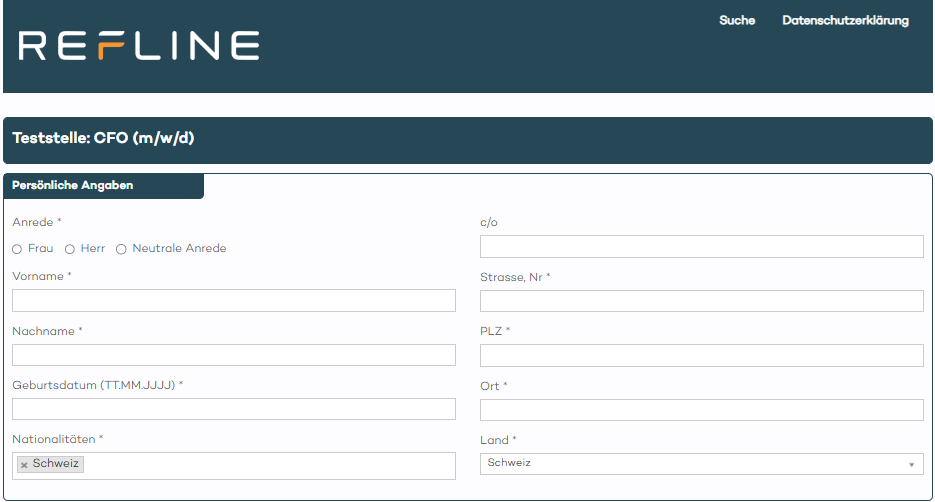Was bedeutet das Kürzel „a“?
Das Kürzel (a) steht in der Stellenbeschreibung dafür, dass alle Personen angesprochen werden, unabhängig ihres biologischen Geschlechts oder ihrer Geschlechtsidentität. Idealerweise wird dazu noch ergänzt, dass (a)lle angesprochen sind.

Was bedeutet das Kürzel „d“?
Das Kürzel „d“ steht in der Stellenbeschreibung für divers. Unter einer diversen Person versteht man unter anderem eine intersexuelle Person, die sich explizit weder als Mann noch als Frau liest – sozusagen zwischen den Geschlechtern steht und medizinisch, hormonell und anatomisch nicht eindeutig zugeordnet werden kann. In Deutschland allein wird die Zahl der Intersexuellen auf um die 100.000 Personen geschätzt. Zu „divers“ gezählt werden auch alle Personen, die sich nicht in das binäre Geschlechtssystem „männlich“ und „weiblich“ einordnen lassen (wollen) und deshalb auch die Bezeichnung „drittes Geschlecht“ ablehnen (z.b. genderfluid). Seit Ende 2017 ist in Deutschland das dritte Geschlecht gesetzlich anerkannt. Das ergeht aus dem Beschluss des Bundesverfassungsgerichts. Danach haben nun alle Intersexuellen und non-binären Personen die Option, sich als „divers“ im Personenstandsregister und Geburtenregister eintragen zu lassen. In der Schweiz gibt es hingegen bisher keine non-binären Geschlechtseinträge.
Seit 01.01.2022 gilt das schweizweit vereinheitliche und stark vereinfachte Verfahren für die (binäre) Änderung des amtlichen Geschlechtseintrages. Personen können dabei einfach beim Zivilstandamt eine Erklärung abgeben (ohne Bestätigungen von Fachpersonen) und der Eintrag wird sofort geändert.
Um eine Diskriminierung bei der Stellenbesetzung zu umgehen, kann die Beschreibung explizit um den Begriff „divers“ erweitert – und dem Spektrum der non-Binarität und Intersexualität somit mehr Sichtbarkeit eingeräumt werden. Zudem wird mit der Erweiterung um „d“ beziehungsweise „i“ das Zwei-Geschlecht-Modell durchbrochen.
Bedeutung von m/w/d: Hintergründe der Kürzel
Eine Diskriminierung aufgrund des Geschlechts ist nicht erlaubt. In der Schweiz greift hierbei das Gleichheitsgebot und Diskriminierungsverbot (Art.8.Abs 1 und 2 BV). In Deutschland greift das Allgemeine Gleichbehandlungsgesetz, kurz AGG, und umgangssprachlich Antidiskriminierungsgesetz genannt. Dadurch werden Stellen nun mit dem Kürzel m/w ausgeschrieben. Das Problem dabei: Was ist mit Personen, die zwischen den Geschlechtern stehen? Bisher griff das AGG für diese nicht – das ist jetzt anders.
Ist eine geschlechtsneutrale Formulierung Pflicht?
In Deutschland müssen seit dem 1. Januar 2019 Stellenanzeigen genderneutral formuliert werden. Doch auch in der Schweiz greifen mehr und mehr Arbeitgeber und HR Verantwortliche auf diese Formulierungen zurück. Entscheidend ist dabei aber in Deutschland nicht nur der Zusatz m/w/d: Der Stellentext selbst muss so eindeutig und klar formuliert sein, dass sich Menschen jeglichen Geschlechts angesprochen fühlen – und signalisiert wird, dass die Stelle ganz geschlechterneutral besetzt werden kann. Damit sich niemand diskriminiert fühlt, gehen die meisten Unternehmen auf Nummer sicher und nutzen m/w/d für ihre Stellenausschreibungen.
In der E-Recruiting-Software von Refline ist es zum Beispiel als Standard möglich, alle drei Anreden aufzuführen. Zusätzlich kann die Kommunikation mit neutralen Variablen gestaltet werden um allen gerecht zu werden und keine Personen auszuschliessen.

Weshalb diese Änderung?
Die Änderung setzt ein Zeichen gegen Diskriminierung anhand des Geschlechts am Arbeitsplatz. Unternehmen unterstehen dadurch einer besonderen Sorgfaltspflicht: sie werden sensibilisiert für eine neutrale, inklusive Ansprache der potenziellen Bewerbenden.
Die Divers–Erweiterung soll dabei keineswegs als „Absicherung“ gesetzlicher Bestimmungen sein. Vielmehr bietet dies eine Chance noch mehr Menschen anzusprechen und bietet sogleich die Möglichkeit alle Personen auf Augenhöhe anzusprechen.
Best Practice-Anwendungen
Falls du dies in deinem Unternehmen entsprechend umsetzen möchtest, dann haben wir folgende Tipps für dich:
Sorge dafür, dass in Deinen Stellenanzeigen (und zum Beispiel auch in unternehmensinternen Mitteilungen) nicht nur die Kürzel m/w/d vorkommen, sondern auch der Text inklusiv ist.
- Berufsbezeichnungen können mit einem Gendersternchen oder Doppelpunkt versehen werden. Meist gibt es auch eine allgemeine Form – wie am Beispiel des „Kaufmanns“/ der „Kauffrau“ sichtbar wird: Hier wäre „Kaufleute“ als neutrale, inklusive Bezeichnung passend.
- Ansprachen/ Anrede offener gestalten: Statt „Liebe*r xy“ zum Beispiel „Hallo + Vornamen“ oder „Liebes Team“ verwenden. Bei der Software von Refline kann die Kommunikation beispielsweise mit neutralen Variablen gesteuert werden.
Um sich ideal vor möglichen Klagen abzusichern, raten Rechtsanwälte Personalabteilungen zu folgenden Massnahmen:
- Die Auswahlkriterien der Bewerbenden sollen so objektiv wie möglich sein.
- Der Bewerbungsprozess wird lückenlos dokumentiert – halte diese Vorgänge unbedingt schriftlich fest.
- Achte darauf, dass im Bewerbungsgespräch mindestens zwei Vertreter des Unternehmens anwesend sind.
- Formuliere das Schreiben im Falle einer Absage so neutral wie möglich, um sich nicht angreifbar zu machen.
- Bewahre alle Unterlagen mindestens drei Monate nach der Absage auf.
Lege besonders viel Wert auf eine inklusive und genderneutrale Stellenausschreibung – so umgehst Du viele damit verbundenen Probleme und Angriffsflächen und sicherst Dich ab.
Weitere geschlechtsneutrale Kürzel und deren Bedeutung
Inzwischen gibt es eine grosse Auswahl an geschlechtsneutralen Kürzeln. Das kann schnell zur Überforderung oder Verwirrung führen. Hier findest Du eine Übersicht über die gängigsten Kürzel. Die Buchstaben sind dabei wie folgt definiert:
- a = alle
- m/w/d = männlich/weiblich/divers
- m/w/i = männlich/weiblich/intersexuell
- m/w/i/t = männlich/weiblich/intersexuell/transsexuell
- m/w/a = männlich/weiblich/anders
- m/w/x = männlich/weiblich/undefiniertes Geschlecht
- m/w/gn = männlich/weiblich/geschlechtsneutral
- m/w/* = männlich/weiblich/Asterisk oder „siehe Fussnote“
An Abkürzungen mangelt es nicht. Wähle die für Dich passende Option. Wichtig dabei: Nutzt Du das Kürzel m/w/i, könnten sich wiederum Transsexuelle diskriminiert und nicht zugehörig fühlen. Die Regelung mit m/w/d bezieht auch diese sowie eindeutig männliche und weibliche Bewerbende mit ein. Lese dazu auch unseren Beitrag über das perfekte Stelleninserat. Achte darauf, alle möglichen Betroffenen bei Deiner Ansprache zu inkludieren – so gehst Du bei jeder Bewerbung auf Nummer sicher.
Der Text wurde am 25. Mai 2021 erstellt und am 14.02.2022 aktualisiert.